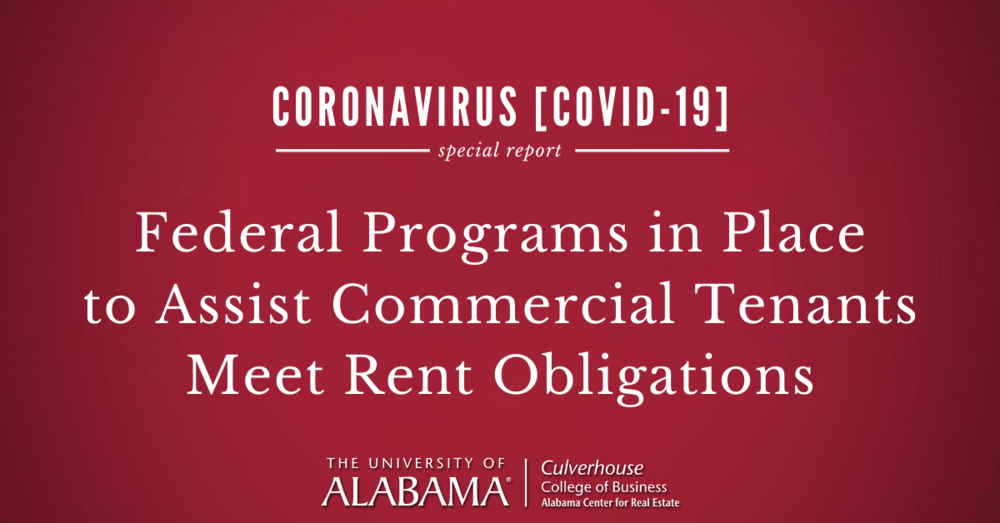If a Landlord defers a Commercial Tenant’s rent obligation, then the obligation does not go away. Rather, the Tenant will be required to pay that rent at sometime in the future. As discussed below, there are federal programs in place to provide many tenants with rent relief – and possibly even rent forgiveness. For most Tenants, having the federal government pay the rent is a better option than asking Landlord to delay the rent.
The Purpose. The federal government passed into law changes to (a) existing disaster relief programs and (b) existing Small Business Administration lending programs on Friday, March 27, 2020. These modifications to existing programs will provide substantial potential benefits to assist many Commercial Tenants in meeting their financial obligations to their Landlords, as well as paying their employees to maintain their workforce and meeting other periodic obligations such as debt service and utility payments.
The Programs. The U.S. Treasury (through the SBA website) is offering the Economic Injury Disaster Loan (EIDL). The Small Business Administration (through your local bank) is offering the Paycheck Protection Program (PPP). The government encourages all Tenants to take immediate action by applying for all applicable relief.
What We Know. The relief legislation was signed into law less than a week ago and is almost 900 pages long. Consequently, the details are not yet fully understood and the Small Business Administration has not yet issued preliminary guidance, rules and regulations (which will surely be changed and amended by interim and final guidance, rules and regulations). The foregoing being the case, much of what is currently available is “opinion” from individual private commentators and analysts. All or part of the currently available information may ultimately prove to be incomplete, partially inaccurate or even entirely wrong. Regardless, all Tenants must make their own decisions and move forward with the best information that is available to them and accepting the risks associated with the reality that “things are changing fast.” Subject to the foregoing, the general consensus currently seems to be as follows:
Economic Injury Disaster Loan (EIDL) – U.S. Treasury through the SBA Website
Commercial Tenants should apply through the Small Business Administration website for the Economic Injury Disaster Loan program.
Immediate Advance Availability. Funds of up to $10,000.00 may be made available within three days of a successful application – i.e. the Emergency Advance.
Possible Advance Forgiveness. Current information releases indicate that the “Emergency Advance” may be “forgiven” in whole or in part (a) depending on the completion of the application process and approval and proof of use of the funds and (b) only if the EIDL loan is “refinanced” into the subsequent Paycheck Protection Program loan and (c) the Tenant meets the requirements for forgiveness of those funds under that program (i.e. the PPP loan). There are a lot of secondary sources circulating at this time which fail to point out that forgiveness under the EIDL is only through the Paycheck Protection Program loan. Consequently, it is important for Commercial Tenants to apply to both programs and include its EIDL loan when computing the amount of its Paycheck Protection Program loan.
Loan Amounts. The Loans may be approved for up to two million dollars to provide support for overcoming the temporary loss of revenue. To be clear, the $10,000 amount is an “advance” on the EIDL. The ultimate EIDL (loan) may be substantially more and is limited to $2,000,000.
Application Process: Commercial Tenants should apply for EIDL advances and loans directly online or call 1-800-659-2955.
Paycheck Protection Program (PPP) (SBA Through Local Financial Institutions).
Commercial Tenants should apply through their existing lenders for the “Paycheck Protection Program (PPP).” Although the application is submitted to a Tenant’s existing lender, information concerning the program is available from the SBA online.
Loan Purpose. PPP loans can be used for payroll costs, health care benefits, pensions, interest on any mortgage obligation, rent and utilities.
Loan Amounts. The maximum PPP loan amount is equal to (a) 250% of the Commercial Tenant’s average monthly payroll costs for the year before the loan was made – presumably, the 365 day period immediately preceding the date of loans application submission — and (b) a refinance of any EIDL funds. There are special rules for employers that do not have a one year history. Payroll costs include compensation paid to owners and the self-employed. Earning in excess of $100,000 a year are ignored – i.e. you can only include a maximum $20,833.33 per highly compensated employee.
Loan Forgiveness. Generally, the loan amount can be forgiven to the extent that the Commercial Tenant can show that the funds were used to satisfy the allowable obligations (payroll, employee benefits, debt service, rent and utilities) so long as the obligation for rents, debt service and utilities existed prior to February 15, 2020 (i.e. the lease, loan or utility service agreement existed prior to February 15, 2020). Furthermore, the payments– regardless of why made – were made after the date that the loan was approved. Loan forgiveness will be reduced if the Tenant reduces employment or if the Tenant reduces salaries and wages by more than 25%. The reduction will be by a ratio similar to the reduction in employment.
Loan Amounts & Forgiveness Amounts Are Computed Differently. Based on what is currently known, it appears that the loan amount is determined solely by reference to payroll while ignoring other operating expenses such as rents and utilities. In contrast, the amount potentially forgiven is determined by looking to amounts spent on payroll, rents, debt service and utilities. This is an important distinction that Tenants should not overlook. Furthermore, as repeatedly noted, the “Final Answers” are not yet really known. Rather, almost everything currently circulating is nothing more than opinion.
Term. The maximum term for the loan is 10 years, with a maximum interest rate of 4% (or lower rate negotiated directly with the lender). The lender cannot charge any loan fees or prepayment penalties.
Application Process. Commercial Tenants should apply for the funds through their existing lenders and, if necessary, other lenders. The loan is technically a 7(a) small business loan. Tenant should not expect any concrete answers from lenders on the process until Friday, April 3, 2020 – at the earliest.
Segregation & Documentation. As noted above, it is unclear what amounts will actually be forgiven. Furthermore, there are restrictions on the proper use of the funds – and those restrictions will be more accurately understood as things progress. Consequently, it is important that Tenants segregate the loan proceeds from all of their other operating funds, loans and grants and carefully document how the loan/grant proceeds are spent.





